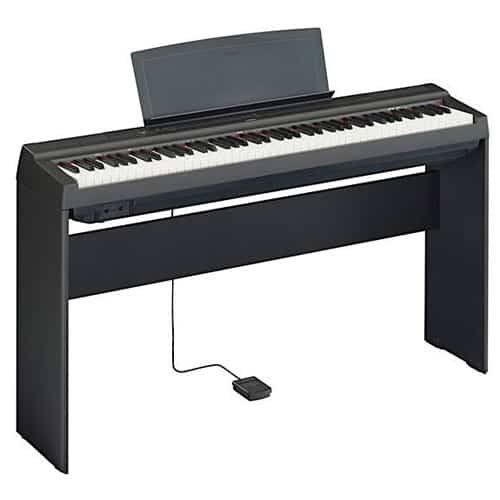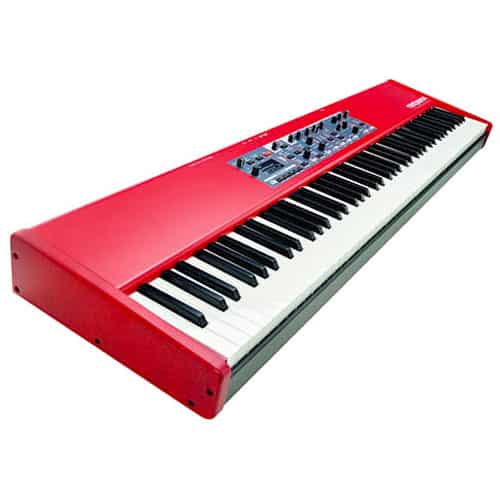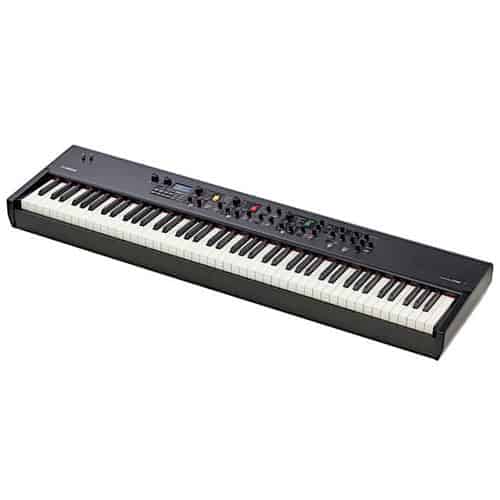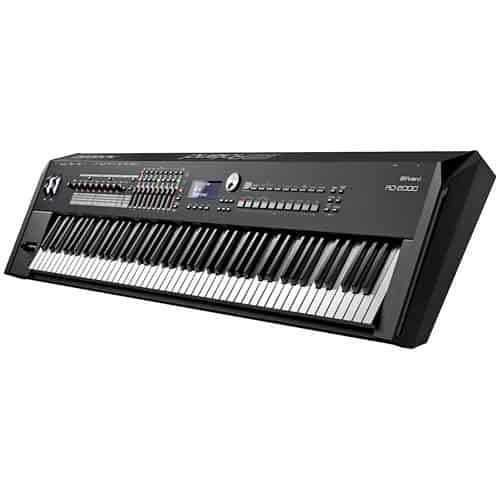Table of Contents
If you want the sound of the world’s finest grand piano in a smaller, more affordable frame, look no further than a weighted keyboard.
These models emulate traditional grand pianos amazingly well and offer plenty of unique voicings for less conventional players.
The Yamaha P125 is our pick for the best weighted keyboard for beginners and veteran players alike. Its lush sound and smooth, realistic feel work well no matter your playing style or experience level.
If you want a different keyboard for the studio or the stage, we’ve highlighted seven other high-quality weighted keyboards that are sure to meet your needs.
So keep reading to learn more about the best weighted keyboard for your style and budget.
The 8 Best Weighted Keyboards:
| Image | Weighted Keyboards | Summary | Check Price |
|---|---|---|---|
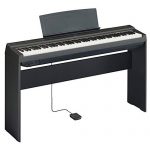 | Yamaha P125 88-Key Weighted Digital Piano | Best Choice: Outstanding hammer action and luscious voices make an outstanding keyboard for recording and performing | Check price |
 | Korg B2SP 88-Key Digital Weighted Keyboard | Best Value: Flexible voicings and articulate keys combine for the best keyboard at an affordable price | Check price |
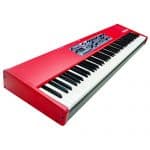 | Nord Piano 4 88-Key Weighted Digital Keyboard | Premium Pick: Unmatched feel and unlimited voices create one of the best weighted keyboards for the stage or studio | Check price |
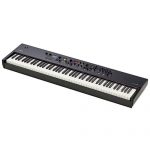 | Yamaha CP88 Stage Digital Piano | Brilliant User Interface: Dynamic voicings and intuitive layout make one of the best stage pianos for tweaking on the fly | Check price |
 | Casio Privia PX-870 Digital Weighted Keyboard | Lifelike Weighted Feel: Class-leading polyphony and best action in a home weighted keyboard | Check price |
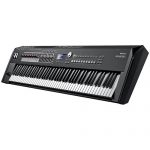 | Roland RD-2000 88-Key Weighted Digital Piano | Massive Sound Bank: Dynamic Roland piano engines with unlimited polyphony and 1,100 sounds on tap | Check price |
 | Korg Grandstage 88-Key Digital Weighted Keyboard | Built to Perform: Sleek stage piano with seven onboard engines for every voice you need | Check price |
 | Yamaha DGX660 88-Key Weighted Digital Piano | Highly Popular Digital Piano: Affordable digital piano with all the tools for songwriting, recording, and practicing | Check price |
Yamaha P125 88-Key Weighted Digital Piano
Yamaha is the creator of some of the best pianos in the industry, so it’s no surprise this brand also sets the standard for weighted keyboards. The P125 is a versatile 88-key model that offers a spacious sound and dynamic feel for new and experienced players alike.
The core of the package is Yamaha’s CF Sound Engine, which offers the sampled tone of a Yamaha CFIIIS concert piano — a classic choice for professional pianists thanks to its power and depth.
In total, the sound engine offers 24 high-quality voices for everything from electric piano to organ, strings and brass.
The P125 also offers premium graded hammer action. As you move up the keyboard, the keys gradually become easier to press and hold, mimicking the feel of a genuine acoustic piano. The built-in hammer mechanisms also offer a realistic simulation of traditional acoustic action.
The stand folds up for easy storage and, because the keyboard itself weighs less than 30 pounds, it’s also easy to transport or move around your house.
Positives
- Fully weighted keys and graded action provide a lifelike and responsive feel
- Two-way speaker system projects up and down for an expansive, organic sound
Negatives
- The sustain pedal included with the keyboard has been described as “flimsy” by some users
- Keys feel a bit glossy, without the authentic texture of acoustic piano keys or a high-end digital model

Korg B2SP 88-Key Digital Weighted Keyboard
The Korg B2SP combines value and durability, making it an awesome pick for anyone searching for a digital keyboard.
The B2SP offers a full 88 keys, with Korg’s “natural weighted” hammer action. This system offers graded action and optimizes the keyboard for light, soft touch. Overall, it offers a solid imitation of acoustic action making it a good choice for intermediate players as well as beginners.
The B2SP offers 12 different sounds, five of which are different acoustic piano voicings. Other sounds include harpsichord, electric piano and organ.
The onboard headphone and USB outputs are clever ways to increase the piano’s versatility. The USB output can also connect to MIDI-enabled devices, so you can use your piano like a MIDI keyboard for sampling and playing unique sounds.
Positives
- 120-note polyphony is outstanding for a keyboard at this price
- MIDI connectivity and USB output make the keyboard more versatile
Negatives
- Not as many voicings as other digital keyboards, particularly non-piano sounds
- Bulky home setup makes it tougher to transport compared to stage digital pianos

Nord Piano 4 88-Key Weighted Digital Keyboard
The Nord Piano 4’s rich, vibrant sound and butter-smooth action make it a fantastic instrument for touring and recording. If you want the absolute best weighted keyboard on the market, it’s hard to top this model.
Nord has put thought into every aspect of the Piano 4. The keyboard includes triple sensors for better response and the action is weighted to match that of standard grand pianos. The Virtual Hammer Action feels supple and smooth, with a light release that’s perfect for trills, staccato accents and glissando.
This keyboard can handle up to 120-note polyphony, so you can play even the most complex pedal passages without notes dropping out.
The Piano 4 includes access to Nord’s piano and synth libraries, with tones from grand pianos to electric pianos, organs, strings, brass and samples. You can easily install these sounds in any of the 120 total onboard slots, and swap them out for new ones using the USB and MIDI connectors.
Positives
- Nord piano and synth libraries let you customize every sound available on your Piano 4
- Virtual Hammer Action system offers outstanding response that’s reminiscent of a real grand piano
Negatives
- No built-in speakers, which forces you to purchase separate gear
- 120-note polyphony is lower than competing stage pianos

Yamaha CP88 Stage Digital Piano
The CP88 has a luscious sound that’s perfect for the studio, but its sleek user interface makes it easy to handle on stage as well.
With graded action powered by natural wooden hammers, the full-size keyboard offers a smooth feel that will be immediately familiar to acoustic piano players. The keys are comfortable for all skill levels. They’re not too light for grand piano players, but also enjoyable for players building their technique.
The heart of the CP88 is its three concert grand piano voicings: The Yamaha CFX and S700, along with the Bösendorfer Imperial 290.
The CFX, Yamaha’s flagship, is balanced and robust, while the S700 offers a more lively, articulate voicing and the Bösendorfer provides shimmering, powerful resonance.
There are 54 additional voicings, ranging from upright and electric pianos to synths, organs, strings and more. You can also add effects like compression, distortion, tremolo and chorus.
Everything is organized into three handy option banks, allowing you to access any of the voices with just a few clicks. It’s the best layout for performing artists who need to keep multiple voicings handy.
Positives
- Lush, vibrant grand piano sounds with sympathetic resonance built in
- Outstanding effects banks let you customize your tone as much as you want
Negatives
- Not as many acoustic piano voices as some other weighted keyboards
- Other stage pianos offer more grand piano sounds

Casio Privia PX-870 Digital Weighted Keyboard
Casio’s Privia PX-870 preserves a lifelike feel and dynamic voices in an affordable package that’s perfect for practicing and jamming. It offers 19 different voices, ranging from a concert grand to electric pianos and 256 notes of polyphony.
The piano is built with scaled hammer action, for genuine touch and feel that shifts in weight as you move up and down the keyboard. Unlike most other weighted keyboards, you can adjust the sensitivity and hammer response to suit your exact playing style.
One thing that sets the PX-870 apart from many competitors is the damper resonance. This feature simulates the resonance of an acoustic piano body for a more accurate sonic picture.
The keyboard also simulates resonance from sympathetic strings for some extra sustain and warmth.
Beyond the keyboard itself, the PX870 includes MIDI and USB compatibility so you can plug straight into an audio interface or recording software.
Positives
- Outstanding scaled hammer action, with tools to adjust resistance to your preference
- Damper resonance and string resonance simulations create authentic sonic picture
Negatives
- User interface is slim and a bit cramped compared to stage pianos
- Some users report that exterior panels scratch easily

Roland RD-2000 88-Key Weighted Digital Piano
As Roland’s latest stage piano, the RD-2000 updates the brand’s famous RD line with dynamic new voicings and a realistic graded hammer action feel. It’s perfect for touring pros, but its massive bank of sounds makes it one of the best weighted keyboards for recording as well.
The RD-2000 runs with two sound engines: the V-Piano engine and the SuperNatural engine. The V-Piano powers the main piano sounds. It’s luscious and rich, with unlimited polyphony for maximum creativity. The SuperNatural engine, meanwhile, recreates famous electric piano tones for authentic, life-like voicings.
Moving beyond classic piano voicings, the RD-2000 raises the bar with more than 1,100 extra sounds on tap. You can pick dynamic voicings for brass, organs, clavinets, synths and many more on command.
The control panel offers plenty of options to tweak your output, like faders, mod wheels and knobs. If you need a piano for playing on stage, these tactile features are a major plus. You can also load in more sounds or record with the RD-2000 using the USB and MIDI I/O banks.
Positives
- 1,100-plus sounds onboard for capturing different types of instruments with unlimited polyphony
- Tactile user interface makes it easy to adjust on stage
Negatives
- No built-in speaker system, which requires you to purchase a separate amplifier
- Some users encounter sudden jumps in output level when switching between voices

Korg Grandstage 88-Key Digital Weighted Keyboard
The Grandstage 88 is a sleek instrument that captures seven beautiful sound engines in a rugged yet refined package. It’s got 500 programs on board, with dedicated engines for acoustic and electric piano tones.
The onboard acoustic engine samples concert grands from Austria, Berlin, Japan and Italy to name a few. The sounds include damper resonance and mechanical noise, allowing you to get the most realistic simulation possible.
The electric engine offers six sampled pianos and onboard Korg synthesis tech. The synthesis lets you adjust the preset sounds to your perfect specifications, going beyond the parameters of basic samples.
Beyond those, you’ll find three more engines for distinct organ tones. A final pair is dedicated to analog-modeled reeds and brass as well as additional keyboard, pipe organ and mellotron tones. For stage performance, you can use the three-band EQ and effects section to quickly dial in the perfect tone.
The RH3 keyboard provides luscious concert grand action, with a graded system to make it feel as realistic as possible. If you find the resistance too heavy, you can always adjust the dynamics knob for real-time adjustments in the playing feel.
Positives
- Seven sound engines provide unmatched quality across different instrument emulations
- Adjustable keyboard provides realistic grand action that you can adjust to your liking
Negatives
- Doesn’t come with a speaker onboard
- Some users report that the default action feels extremely heavy without adjustments

Yamaha DGX660 88-Key Weighted Digital Piano
Rounding out our list is one of the most popular digital pianos on the market: the Yamaha DGX660. With graded hammer action and the voice of a Yamaha CFIIIS concert grand, it offers an upscale tone for players at all levels.
Yamaha’s CF Sound Engine powers the DGX660. With more than 150 voices, including different types of pianos and other instruments, it’s got plenty of variety for recording and performance.
You can adjust the grand piano tone with the new Piano Room feature. This is a detailed editor that lets you add damper resonance, switch room ambience and even adjust the lid position of the virtual piano.
With 192 voices of polyphony and 300-plus effects voicings in reverb, chorus and delay, the DGX660 is powerful enough for any situation.
Unlike most other keyboards, the DGX660 also lets you connect a microphone to sing directly through the speakers, or play back uncompressed MIDI songs and WAV files. It’s the perfect tool for singer-songwriters looking for a digital piano to record and accompany themselves.
Positives
- 192 voices of polyphony and 300 effects voicings for fresh sounds every time
- Piano Room software provides outstanding control over every aspect of the piano
Negatives
- No full-size MIDI I/O bank
- Keyboard is fairly heavy, particularly with full stand set up

What are Weighted Keys?
Fully weighted keys incorporate wooden or synthetic weights to provide resistance when you press down on the keys; they’re what you’ll find on acoustic pianos and the best digital keyboards. Piano players love weighted keys because they offer a dynamic, responsive feel with outstanding touch and articulation.
If you’re looking for the best weighted keyboards, it’s important to understand the different types of weighted keys on the market. Let’s take a closer look at the most common varieties.
The Difference Between Semi-Weighted Keys and Weighted Keys
Weighted keys come in multiple categories, usually classified as “semi-weighted” and “fully weighted.” The difference between them is the amount of resistance you feel when you press down onto a key.
Semi-weighted keyboards feel closer to unweighted digital pianos. They offer a little bit of resistance, but it’s very easy for players to press down on the keys. Most of these keys use built-in springs for this type of action, rather than genuine weights incorporated into the key.
Fully weighted keys provide more resistance and rebound more naturally when you take your finger off of the key. This helps you perform techniques like trills, glissandos and extremely smooth legato.
Fully weighted keys are the gold standard among weighted keyboards because they’re closer to a genuine piano action and they feel more organic underneath your fingers.
Are Weighted Keys Better?
While weighted keys often cost more than unweighted alternatives, the upgrade offers a few major benefits. Unlike unweighted synth keyboards, weighted keyboards mimic the dynamics and feel of acoustic pianos. That makes them a lot more responsive to your touch and more enjoyable to play.
If you’re just starting out, learning to play with acoustic-style action is crucial for your technique. More advanced players will appreciate the lifelike response and classic touch that weighted keyboards provide.
The weighted action does have some concrete benefits for your technique as well. Because of their natural springiness and extra body, weighted keys are perfect for performing tricks like trills and rapid accents.
Hammer Action Weighted Keys vs. Graded Hammer Action
“Graded” hammer action means each key is weighted differently. The bass keys are heavier and more difficult to press down, while the treble keys offer less resistance for a smoother, softer touch.
Graded hammer action mimics the action in an acoustic piano, where the heavier bass hammers make the lowest keys tougher to press. This is important to help new players form proper muscle memory, and it’s great for experienced players who are used to the feel of an acoustic piano.
Keyboards without graded hammer action offer one level of resistance across the entire keyboard. Like graded hammer action pianos, these keyboards use genuine hammers to provide a more realistic touch and release. They just don’t adjust the weight between different keys.
While these digital pianos are better than those without hammer action, they’re not quite as realistic as graded weighted keyboards. If you want the most realistic experience possible, graded hammer action is essential.
What is the Best Weighted Keyboard for Beginners?
If you’re buying a weighted keyboard for beginners, it’s important to pay attention to both tone and feel.
A dynamic piano voice will inspire you to come back to the instrument time and time again. Whether it’s a concert piano, electric piano, or even an organ voice, it’s crucial to find a digital piano that motivates you to play.
It’s also important to consider the action. The closer your digital piano feels to a genuine acoustic piano, the better your technique and endurance will be. Look for a model with graded hammer action and keys with simulated ebony and ivory textures.
Of course, it’s also important to consider your needs and budget for a beginner piano. Expensive stage keyboards like the Yamaha CP88 or Roland RD-2000 might sound and feel fantastic, but they don’t include speakers and need a keyboard amplifier or headphones to use, and cost much more than other solid options.
Cheaper keyboard pianos with 88 keys, like the Yamaha P125 or Casio Privia P870, each make an outstanding weighted keyboard for beginners. They have plenty of voices for new players to explore and they feel great with authentic graded action.
Bottom Line
The Yamaha P125 is our pick for the best weighted keyboard because of its beautiful sound engine and lifelike graded action in a lightweight, affordable package.
Even if the P125 isn’t for you, there are plenty of other great digital piano models to take for a test drive. If you need a performance-ready instrument, the Yamaha CP88 or Korg Grandstage could be just what you’re looking for.
Do you prefer a weighted keyboard or a classic acoustic piano? How do you use your digital piano: on stage or around the house? Let us know in the comments below.
